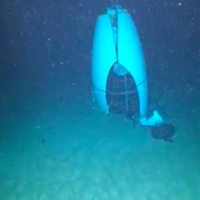
(WASHINGTON) — A piece of the Titan’s carbon-fiber hull recovered after the submersible’s deadly catastrophic implosion showed “anomalies,” a National Transportation Safety Board engineer said Wednesday during a weekslong hearing on the incident.
Don Kramer, the acting chief of the NTSB’s materials laboratory, testified during the U.S. Coast Guard’s hearing into the June 2023 implosion of the OceanGate submersible while on a deep-sea dive to the Titanic shipwreck.
Kramer said his team examined material from the manufacturing of the hull and found “several anomalies within the composite and the adhesive joints, including waviness, wrinkles, porosity and voids.”
They also examined a piece of the hull recovered from the ocean floor and found similar anomalies, including “waviness and wrinkles within the hull layers” and voids within the adhesive that joined the layers, he said. The recovered hull also showed “features consistent with rubbing damage at one of those adhesive joints.”
Kramer said the Titan debris on the ocean floor showed that the hull “encountered a significant amount of delamination” — or separating into layers — most of which was within or adjacent to co-bonded adhesive interfaces.
Asked by OceanGate’s counsel whether any of the delaminations, voids or rubbing damage could have been present before the implosion, as opposed to being caused by the implosion, Kramer said he is not offering analysis as to when they occurred.
Further asked by OceanGate’s counsel whether any of the issues he observed could have caused the implosion, Kramer said that is “still subject to our own internal analysis at this point.”
Kramer also discussed the loud bang passengers heard as the Titan ascended during a dive that occurred a year before the implosion, on July 15, 2022 — referred to as dive 80. The bang was also detected by the Titan’s real-time monitoring system, which had sensors to detect acoustic events, as well as multiple strain gages to monitor mechanical strain, he said.
Kramer said his team determined that the hull’s strain response changed after this loud bang incident in subsequent dives in 2022. He said the strain gage data showed a change in the strain in the hull for four of the eight gages.
“Those changes persisted from dive to dive,” he said.
There was no difference when comparing the strain response to a dive prior to dive 80, Kramer said.
No strain data is available for dives conducted in 2023, according to Kramer.
Phil Brooks, OceanGate’s former engineering director, testified on Monday that following the loud bang on dive 80, the strain gage data showed a minor “shift,” though they did not see “any further shifts in strain data” on subsequent dives in 2022. Nothing “really seemed out of the ordinary,” and OceanGate co-founder and CEO Stockton Rush made the decision to continue dives, Brooks said.
Asked how his team arrived at its determination on the change in strain response based on the graphs of the available data, Kramer said, “I guess it’s a matter of opinion as to whether one can discern the changes in strain output.”
Brooks said Rush theorized that the loud bang was caused by the frame “readjusting back to its original shape” as it returned to the surface.
Kramer noted that the NTSB’s investigation is still ongoing, and the scope of his presentation was therefore limited.
OceanGate suspended all exploration and commercial operations after the deadly implosion, which killed five people, including Rush.
The two-week hearing on the incident is scheduled to run through Friday.
The main purpose of the hearing is to uncover the facts related to the implosion and to make recommendations, the Coast Guard said.
Copyright © 2024, ABC Audio. All rights reserved.















